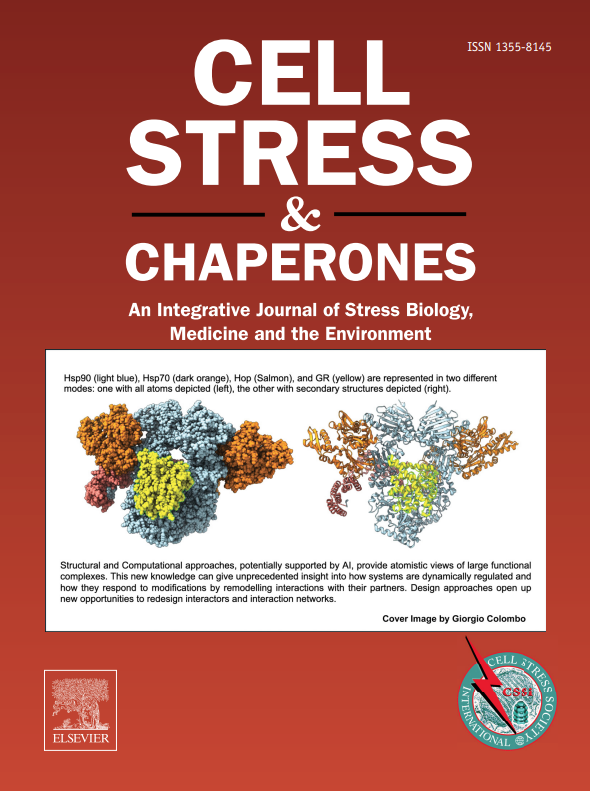Components of a mammalian protein disaggregation/refolding machine are targeted to nuclear speckles following thermal stress in differentiated human neuronal cells
IF 3.3
3区 生物学
Q3 CELL BIOLOGY
引用次数: 0
Abstract
Heat shock proteins (Hsps) are a set of highly conserved proteins involved in cellular repair and protective mechanisms. They counter protein misfolding and aggregation that are characteristic features of neurodegenerative diseases. Hsps act co-operatively in disaggregation/refolding machines that assemble at sites of protein misfolding and aggregation. Members of the DNAJ (Hsp40) family act as “holdases” that detect and bind misfolded proteins, while members of the HSPA (Hsp70) family act as “foldases” that refold proteins to biologically active states. HSPH1 (Hsp105α) is an important additional member of the mammalian disaggregation/refolding machine that acts as a disaggregase to promote the dissociation of aggregated proteins. Components of a disaggregation/refolding machine were targeted to nuclear speckles after thermal stress in differentiated human neuronal SH-SY5Y cells, namely: HSPA1A (Hsp70-1), DNAJB1 (Hsp40-1), DNAJA1 (Hsp40-4), and HSPH1 (Hsp105α). Nuclear speckles are rich in RNA splicing factors, and heat shock disrupts RNA splicing which recovers after stressful stimuli. Interestingly, constitutively expressed HSPA8 (Hsc70) was also targeted to nuclear speckles after heat shock with elements of a disaggregation/refolding machine. Hence, neurons have the potential to rapidly assemble a disaggregation/refolding machine after cellular stress using constitutively expressed Hsc70 without the time lag needed for synthesis of stress-inducible Hsp70. Constitutive Hsc70 is abundant in neurons in the mammalian brain and has been proposed to play a role in pre-protecting neurons from cellular stress.
在分化的人类神经元细胞中,哺乳动物蛋白质分解/重折叠机的成分在热应激后靶向于核斑点。
热休克蛋白(Hsps)是一组高度保守的蛋白质,参与细胞修复和保护机制。它们能对抗蛋白质的错误折叠和聚集,而这正是神经退行性疾病的特征。Hsps在分解/重折叠机器中协同作用,在蛋白质错误折叠和聚集的部位聚集。DNAJ(Hsp40)家族成员充当 "保持酶",检测并结合错误折叠的蛋白质,而HSPA(Hsp70)家族成员则充当 "折叠酶",将蛋白质重新折叠成具有生物活性的状态。HSPH1(Hsp105α)是哺乳动物分解/重折叠机器的另一个重要成员,它作为分解酶促进聚集蛋白质的解离。在分化的人类神经元 SH-SY5Y 细胞中,分解/重折叠机的组成成分在热应激后被靶向到核斑点上,它们是HSPA1A(Hsp70-1)、DNAJB1(Hsp40-1)、DNAJA1(Hsp40-4)和HSPH1(Hsp105α)。核斑点富含 RNA 剪接因子,热休克会破坏 RNA 剪接,而 RNA 剪接会在应激刺激后恢复。有趣的是,组成型表达的 HSPA8 (Hsc70) 在热休克后也被靶向到核斑点上,具有分解/重折叠机器的元素。因此,神经元有可能在细胞应激后利用组成型表达的 Hsc70 快速组装分解/重折叠机器,而不需要应激诱导型 Hsp70 合成所需的时间滞后。组成型 Hsc70 在哺乳动物大脑的神经元中含量丰富,被认为在保护神经元免受细胞应激方面发挥了作用。
本文章由计算机程序翻译,如有差异,请以英文原文为准。
求助全文
约1分钟内获得全文
求助全文
来源期刊

Cell Stress & Chaperones
生物-细胞生物学
CiteScore
7.60
自引率
2.60%
发文量
59
审稿时长
6-12 weeks
期刊介绍:
Cell Stress and Chaperones is an integrative journal that bridges the gap between laboratory model systems and natural populations. The journal captures the eclectic spirit of the cellular stress response field in a single, concentrated source of current information. Major emphasis is placed on the effects of climate change on individual species in the natural environment and their capacity to adapt. This emphasis expands our focus on stress biology and medicine by linking climate change effects to research on cellular stress responses of animals, micro-organisms and plants.
 求助内容:
求助内容: 应助结果提醒方式:
应助结果提醒方式:


